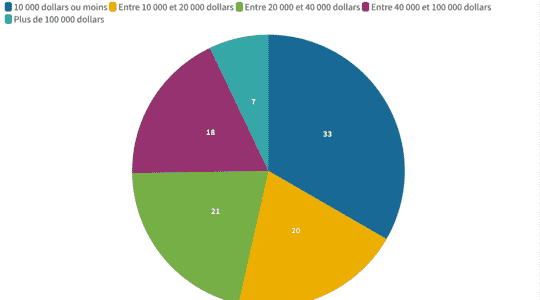The new American generation could gain in lightness. On Wednesday August 24, Joe Biden defended his decision to partially erase the colossal student debt weighing on his fellow citizens. Two years after his arrival at the White House, the septuagenarian goes to the bedside of youth, resuming a campaign promise aimed at benefiting “above all to families of the middle and working class”. Are concerned by this abatement: people with less than 125,000 dollars per year, or those belonging to households earning less than 250,000 dollars per year.
To view the graph, click here.
Concretely, the measure erases 10,000 dollars for people who have not benefited from a federal grant for their university studies (also called Pell grants) and 20,000 dollars for those, with more modest means, who have received one. Note that 60% of borrowers have received Pell grants and the majority come from families earning less than $30,000 per year, indicates the New York Times. The White House estimates that nearly 90% of the relief will go to people earning less than $75,000, and that around 20 million borrowers could see their debt completely forgiven.
If Joe Biden’s measure resonates so strongly in the country, it is because the subject concerns a large part of the population: in total, forty-five million people have student loan debt, or about one in seven Americans ( 13.5%), according to an analysis of census data from January 2022. Among young people who have taken out a loan, 33% have borrowed $10,000 or less. 7% of them have to repay $100,000 or more. In addition to students and ex-students, Joe Biden’s measure also provides relief for parents who had taken out a loan in place of their children under the Parent Plus Loans program.
$200,000 loan for medical studies
On the other side of the Atlantic, the unequal nature of higher education regularly comes up on the table. And for good reason: universities can charge from 10,000 to 70,000 dollars a year with significant differences between courses. For example, the average debt for medical students is $201,490 compared to $145,500 in law and $28,950 for a bachelor’s degree in general, list NerdWallet. Amounts difficult to evade when choosing its orientation. Generally, public colleges will be less expensive than private colleges, but it is possible to get more financial aid at a private school, helping to compensate.
To view the graph, click here.
According to a report by the United States Federal Reserve (the Fed) from June 2021, the total amount of student loans in the United States reached $1.7 trillion, the second largest item of household debt behind real estate. . Faced with such a financial windfall, the debate on student loans was particularly heated, as it always is in the United States when it comes to transferring to the public authorities expenditure that had hitherto been private, whether in the health or education sector. It took more than a year and a half for the White House to calibrate its plan and find a legal basis for its action.
“The expense is worth it not only for questions of social justice”, but also for “America to win the economic competition of the 21st century” thanks to education, justified Joe Biden during a speech at the White House. “How do we finance it? By what we have done”, namely the reduction of the deficit. White House domestic policy adviser Susan Rice admitted that the administration has not yet determined the cost of student debt relief: it will depend on how many people apply for it. According to some estimates, it could cost $300 billion or more.
What make some members of the Democratic camp jump, at a time when the United States is already facing soaring prices. Jason Furman, former economic adviser to Barack Obama, thus estimated on Twitter that he was “unconscious to throw around 500 billion dollars of oil on the fire of inflation which is already blazing. Proof that the Democratic camp is divided on the file, the senators Chuck Schumer and Elizabeth Warren, them, evoked in a joint press release “a giant step towards the resolution of the crisis of the student debt”.
Unsurprisingly, the Republican camp expressed its displeasure. Their Senate leader Mitch McConnell couldn’t find words harsh enough against an “incredibly unfair” measure. “It’s a slap in the face for all the families who have made sacrifices to save for college, for all the graduates who have repaid,” he said in a statement. The chief economist of the Moody’s agency, Mark Zandi, on the contrary estimated that the impact of this debt relief on growth as on inflation would be “marginal”.
Joe Biden, however, stressed that the moratorium on the repayment of student loans, introduced during the Covid pandemic, would end at the end of the year. And that it will therefore be necessary thereafter, after deducting the aid announced on Wednesday, to resume reimbursements. Three months before the traditionally difficult mid-term elections for the presidential party, the 79-year-old Democrat is playing the “Middle Class Joe” card (“Middle Class Joe”, Editor’s note). Whether this boost will pay off remains to be seen.
